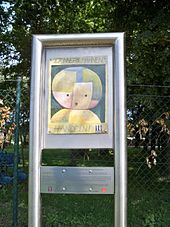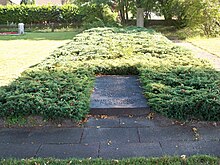Children's camp Rieten
The children's camp in Rüsten (at that time the official Foster Care Center for foreigners in Rorien ) in Ränen near Wolfsburg was a camp for children of female forced laborers at the end of the Second World War . According to various sources, between 100 and 365 children died there within a few months.
geography
The camp was located about one kilometer east of what was then the outskirts of the town of Rühren on the road to Grafhorst not far from the Mittelland Canal .
history
Until the end of World War II
In the final phase of the Second World War, the newborn children were placed by forced laborers in so-called foreign child foster homes so that their mothers could go back to work. There were several such warehouses at the Volkswagen plant in Wolfsburg . The newborn children of the Polish and Soviet forced laborers were first placed in a home on Schachtweg in Wolfsburg. Initially after six to eight weeks, later after eight to ten days, they were separated from their mothers so that they could go back to work. Numerous children died due to inadequate care. On June 14, 1944, the healthy children were transferred to a former camp of the Reich Labor Service established in 1934 , while the sick children remained in the Wolfsburg camp. Later the remaining children from Wolfsburg were also brought to Rüben. One reason for moving the children to Rüben was fear of unrest among the forced laborers because of the high death rate of the children.
The Rübener camp consisted of four barracks. There were around 130 children in each camp. The maternity ward was located in a barrack, in which female forced laborers from the Gifhorn district had to give birth to their children before they, like the other mothers, had to return to their jobs after a few days. The parents were allowed to visit their children on Sundays, but had to cover the twelve-kilometer walk from Wolfsburg. The parents had to pay RM 27 per child per month for accommodation. The chief company doctor at the Volkswagen factory, Hans Körbel , was responsible for the children's health. After initially doing about three visits a week, he later limited himself to weekly visits, during which he almost only issued death certificates. The care of the children was the responsibility of a head nurse , some forced laborers and a 24-year-old doctor without training who became permanently ill at the end of 1944.
Another camp nearby was the Velpke care facility for foreigners , which existed until December 14, 1944 and whose surviving children were brought to Rorien. According to various sources, between “over 100” and “at least 365” children had died in the children's camp in Rorien by April 1945. The causes were gastroenteritis and other diseases that were due to malnutrition due to the lack of breast milk and poor hygienic conditions, especially vermin such as bed bugs and human lice. This often resulted in cross-infections . The death rate for children was initially around 70 percent, later almost 100 percent. The cause of death was mostly “weakness of life” or “congenital weakness of life”. To the end, Körbel failed to ask expert pediatricians for advice. The first dead children from the camp were buried in wooden coffins in the Rhenish cemetery; later cardboard boxes were used or containers were dispensed with altogether and several children were buried in the same grave. In some cases, children's corpses in cardboard boxes were transported by bike from the children's camp to the cemetery two kilometers away. The grave field initially consisted of numerous disordered heaps of earth, on which vertical branches pointed to the dead. The grave sites were not registered by name. The parents had to pay the funeral expenses with 20 RM each.
aftermath
Hans Körbel was on 24 June 1946 a British military court in Helmstedt due to "willful neglect" ( willful neglect ) to death by train convicted. Despite numerous requests for clemency, including from church circles, the sentence was carried out on March 7, 1947 in Hameln penitentiary . The head nurse responsible was also sentenced to death, but received a lighter sentence in an appeal and was released from prison after nine years. The files of the children's camp used in the trial have been lost since the trial.
In 1970 the roughly three by ten meter grave site in the Rhenish cemetery was bordered by the community and planted with ground-covering coniferous trees. At the edge of the grave is a pillar with a square plan on which the Lord's Prayer is engraved. A commemorative plaque added in 1988 explains the fate of the children.
The British John Murdoch wrote the play The Children of Dr. Basket. It is occasionally performed in Wolfsburg and other locations by Murdoch's theater company. The "Week of Antifascism " organized by IG Metall Wolfsburg, which mainly represents the employees of the Volkswagen factory, began in 2010 at the grave site in Rüllen. Also present was the former forced laborer Sara Frenkel , who had worked in infant care under a false name until the camp was moved to Wolfsburg and who in the 1980s had campaigned for the dignified design of the children's graves. In 2012, a street in Wolfsburg was named after Sofia Gladica, who died in the Rhenish children's camp. Sara Frenkel took care of this girl after she was moved from Wolfsburg to Ränen.
The barracks have not been preserved. On the site there are partly vacant houses and the hall of an association for historical agricultural machinery. On May 9, 2014, a memorial plaque was placed on the edge of the site for the first time. The initiators were IG Metall Wolfsburg and VVN Wolfsburg; A class from the local high school took part in the celebration . Representatives of the community were not present at the inauguration.
In 2016, a “history and remembrance plaque” was set up by the municipality of Ränen and the Volksbund Deutsche Kriegsgräberfürsorge on the edge of the burial ground. The detailed text is based on the work of students from the Eichendorff School in Wolfsburg. The number of 274 children buried in the grave is given on the tablet. In 2019 the burial ground was redesigned by citizens of Rhenish; a weathered grave slab with the life data of a child was discovered.
Three surviving children are known by name. One of these children, Waldemar Krassmann, was fetched from the home by his parents on one of the weekly visits; then the family fled towards Brome . Krassmann also attended the inauguration of the table in 2016. In January 2020, his son performed a letter from him addressed to the audience at the play “Memoria”, which was performed by students from Wolfsburg in collaboration with the Israeli artist Eyal Lerner. In this letter he reports on his rescue and thanks everyone involved in the play for their commitment.
literature
- Marcel Brüntrup: Crime and Memory. The Volkswagenwerk's foreign nursing home. Wallstein Verlag 2019, ISBN 978-3-8353-3453-3 .
- Klaus-Jörg Siegfried: The life of the forced laborers in the Volkswagen factory 1939–1945. Campus, Frankfurt (Main) / New York 1988, ISBN 3-593-34004-6 , pp. 235-255.
- Günter Barthel among others: Rorien, Brechtorf and Eischott in pictures . Horb am Neckar 2004, ISBN 3-89570-929-8 , pp. 80-84.
Movies
- Jens Winter: Children's camp Rorien: June 1944 - April 1945. Medienwerkstatt Isenhagener Land, Hankensbüttel (DVD)
Web links
- Uwe Pitz: Born to die in the Rühren camp. 2nd edition 2013 (PDF; 8.5 MB)
- Information at antifa.sfa-blog.com
- Information at weltkriegsopfer.de
- Memorial ceremony in Rüsten 2010 at waz-online.de
- Historical photo of the Rüben children's camp
- Report on the commemoration campaign on the 69th anniversary of the end of the war in 2014 ( memento from May 12, 2014 in the Internet Archive ) by the NDR (archive version)
Individual evidence
- ↑ Documentation of the forced labor camps , accessed on August 5, 2011
- ↑ a b c VVN website , accessed on June 7, 2014
- ↑ Information at weltkriegsopfer.de ( Memento from April 11, 2013 in the Internet Archive )
- ↑ Günter Barthel, among others: Ränen, Brechtorf and Eischott in pictures. Horb am Neckar 2004, ISBN 3-89570-929-8 , p. 80.
- ^ A b Johann Dietrich Bödecker: The land of Brome and the upper Vorsfelder Werder. History of the room at Ohre, Drömling and Kleiner Aller. Braunschweig 1985, ISBN 3-87884-028-4 , pp. 567-569.
- ^ Klaus-Jörg Siegfried: The life of the forced laborers in the Volkswagen factory 1939–1945. Campus, Frankfurt (Main) / New York 1988, ISBN 3-593-34004-6 , p. 242.
- ↑ Uwe Pitz: Born to die in the Rorien camp (PDF page 30) 2nd edition 2013 (PDF; 8.5 MB)
- ↑ a b c Information at antifa.sfa-blog.com , accessed on August 6, 2011
- ↑ Günter Barthel, among others: Ränen, Brechtorf and Eischott in pictures . Horb am Neckar 2004, ISBN 3-89570-929-8 , p. 83
- ^ A b Klaus-Jörg Siegfried: The life of the forced laborers in the Volkswagen factory 1939–1945. Campus, Frankfurt (Main) / New York 1988, ISBN 3-593-34004-6 , p. 248.
- ↑ see memorial plaque in the cemetery
- ^ Klaus-Jörg Siegfried: The life of the forced laborers in the Volkswagen factory 1939–1945. Campus, Frankfurt (Main) / New York 1988, ISBN 3-593-34004-6 , p. 243.
- ↑ Bernhild Vögel: “Maternity Home for Eastern Workers” Braunschweig, Broitzemer Straße 200. Article on the treatment of forced laborers in Braunschweig and the surrounding area (PDF file, 2.6 MB), accessed on August 6, 2011
- ^ Klaus-Jörg Siegfried: The life of the forced laborers in the Volkswagen factory 1939–1945. Campus, Frankfurt (Main) / New York 1988, ISBN 3-593-34004-6 , p. 244.
- ↑ Günter Barthel, among others: Ränen, Brechtorf and Eischott in pictures . Horb am Neckar 2004, ISBN 3-89570-929-8 , p. 84.
- ↑ Günter Barthel, among others: Ränen, Brechtorf and Eischott in pictures . Horb am Neckar 2004, ISBN 3-89570-929-8 , p. 82, photo of the grave site immediately after the end of the war.
- ↑ Information on Hans Körbel ( Memento from January 1, 2015 in the Internet Archive )
- ↑ Brief description of the piece , accessed on December 30, 2014
- ↑ Moving commemoration with a contemporary witness in Rühren. on: waz-online.de , November 8, 2010, accessed on February 3, 2016
- ↑ Report on the memorial action for the 69th anniversary of the war's end in 2014 ( Memento of 12 May 2014 in the Internet Archive ) by the NDR , accessed on May 11, 2014
- ^ A b Erik Westermann: blackboard explains the fate of Nazi victims. In: Gifhorner Rundschau of May 4, 2016, p. 23.
- ↑ Alexander Täger: IG Metall commemoration commemorates the victims of the National Socialist children's camp. waz-online.de of November 16, 2019, accessed on December 22, 2019
- ↑ Erik Westermann: "Sheer luck that I survived". In: Gifhorner Rundschau from November 23, 2013.
- ^ "Memoria" in the theater: Impressive performance by 160 students. Retrieved January 29, 2020 .
- ↑ Crime and Memory. The Volkswagenwerk's »foreigners' nursing home«. wallstein-verlag.de, accessed on April 19, 2019.
Coordinates: 52 ° 28 ′ 57.1 ″ N , 10 ° 54 ′ 13 ″ E




